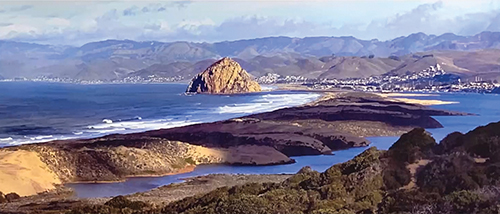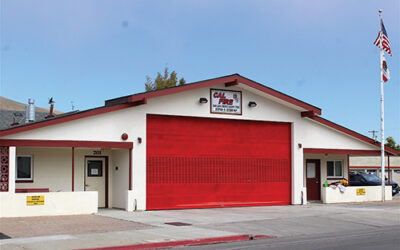Will the Morro Bay smokestacks be torn down as an industrial eyesore or left up as a nostalgic landmark?
The Morro Bay City Council began exploring that question at a recent online meeting that featured a near bombshell revelation — if they stay, the City will be 100-percent responsible for their upkeep, inspections, regulatory compliance and eventual removal.
The Zoom meeting had over 200 people tuned in form the community plus representatives from the power plant’s parent company, Vistra, and government regulators discussing the current status and future of the trio of monoliths.
And while it wasn’t officially part of the discussion, Vistra’s application to build the world’s largest Battery Energy Storage System (BESS), at the power plant loomed large in the minds of the public.
The City and Vistra entered into a memorandum of understanding in June regarding the BESS and the future of the over 100-acre waterfront property. The MOU and a court settlement on an eminent domain suit the City had brought as part of the its Water Reclamation Facility or WRF and reached at virtually the same time, included Vistra’s pledge to remove the power plant generation building and stacks.
The company however left the door open for the City to ask they be left standing. The MOU says the City has until the end of 2022 to give the company a decision. If Vistra fails to tear down the plant and possibly the stacks by 2028, they have to pay the City $3 million.
The City Council decided to pose the question to the community and the Sept. 8 meeting was the first chance. City Manager Scott Collins said they’d gotten over 40 emails and letters on the subject, indicating the strong public interest.
Vistra Senior Vice-President for Corporate Development & Strategy, Claudia Morrow summed up their position. “They serve no purpose,” Morrow said of the stacks. They were built tall (450 feet) to better disperse the emissions from the old plant, as it began operations burning fuel oil, diesel and kerosene, before switching to natural gas in the mid-1990s.
The plant has been shuttered since 2014 and with Vistra’s turn towards battery plants, they decided to tear down the old plant rather than continue to maintain it, and then work with the City on possible redevelopment.
Several issues remain in the way of anything being built there, including a deed restriction Pacific Gas & Electric — who built the over 60-year-old plant — placed on future uses, essentially that it must remain an industrial use.
That would mean any contamination in the soil and groundwater would not have to be cleaned up, something PG&E as well as Vistra could be liable for.
The stacks are structurally sound despite getting a good shake during the December 2003 San Simeon Earthquake, which this reporter, as well others, witnessed on that day.
Vistra’s Director of Decommissioning & Demolition, Dianna Tickner said so long as maintenance is kept up, “the structural integrity should remain good.” She added that the stacks did not sustain any damage during the quake and if maintained could last another 100 years.
Morrow said every 2-5 years, they must complete visual inspections of the stacks for structural integrity, which means climbing them and looking for cracks and other flaws. This past June, the stacks were inspected for contamination that could become airborne, which is done through the County Air Pollution Control District.
APCD’s Tim Fuhs, the compliance supervisor, said all they found in June was some “rust and bird droppings.” He also said that the stacks have very little asbestos. The generator building has a lot of asbestos, however, as its miles of steam piping and boilers are all blanketed in the stuff.
But it was an audience member who got to the heart of the matter asking who would be responsible for the stacks if the City decides to keep them? Morrow said Morro Bay would be responsible.
She said if the City chooses to keep them, then the City would be responsible for their maintenance and liability, as well as a future removal, which could cost over $5 million.
As a reference point, Don Maruska, who moderated the meeting, put together a chart showing the costs to the City that he was able to glean from the discussion. It should be noted that these are rough estimates not based on detailed studying of the matter.
Maruska listed $250,000 per stack for custom-made “caps” to protect the interiors; $10,000 a year for insurance (if the stacks are not “repurposed” and much more for something like base or bungee jumping were started); $50,000 a year for inspections; and listed $2-$5 million in a reserve fund for their eventual removal.
Having Vistra remove them would cost the City nothing.
The meeting was the first step in this process and given the deadline for a decision isn’t until the end of 2022, it will likely be a campaign issue in the June 2022 special election when one council seat will be on the ballot, and for the general election in November 2022, when the mayor and two council seats will be on the ballot; although the Council could make a decision sooner and put the issue to rest.



